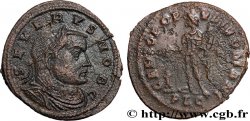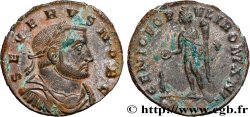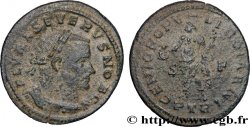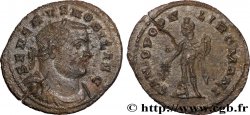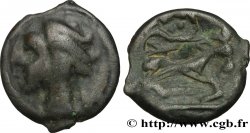brm_444264 - SEVERUS II Huitième de follis ou quinaire
Nicht verfügbar.
Artikel auf unserem Online-Shop verkauft (2018)
Preis : 350.00 €
Artikel auf unserem Online-Shop verkauft (2018)
Preis : 350.00 €
Type : Huitième de follis ou quinaire
Datum: 305
Name der Münzstätte / Stadt : Roma
Metall : Scheidemünze
Durchmesser : 16,5 mm
Stempelstellung : 6 h.
Gewicht : 2,10 g.
Seltenheitsgrad : R3
Kommentare zum Erhaltungszustand:
Exemplaire sur flan épais, parfaitement centré des deux côtés avec les grènetis visibles. Beau portrait de Sévère II. Joli revers inhabituel. Patine vert foncé
N° im Nachschlagewerk :
Pedigree :
Cet exemplaire provient du stock d’Alain Poinsignon et de la collection MG
Vorderseite
Titulatur der Vorderseite SEVERVS NOB CAES.
Beschreibung Vorderseite Buste lauré, drapé et cuirassé de Sévère II César à droite, vu de trois quarts en avant (A*).
Übersetzung der Vorderseite “Severus Nobilissimus Cæsar” (Sévère très noble césar).
Rückseite
Titulatur der Rückseite PRINCIPI IVENTVTIS.
Beschreibung Rückseite Le prince vêtu militairement debout à droite, tenant une haste transversale de la main droite et un globe de la main gauche.
Übersetzung der Rückseite “Principi Iuventutis” (Au prince de la jeunesse).
Kommentare
Rubans de type 3. Sans césure dans la légende de revers. Ptéryges invisibles sous le paludamentum. Monnaie divisionnaire liée à un donativum, certainement à l’occasion de l’accession de Sévère II au césarat le 1er mai 305. Le poids de cet exemplaire (2,10 g) semblerait indiquer plutôt un quart de follis (denier) qu’un huitième de follis (quinaire), mais son diamètre et son type semblent plutôt le faire entrer dans cette seconde catégorie.
Type 3 ribbons. Without caesura in the reverse legend. Pteryges invisible under the paludamentum. Divisional coinage linked to a donativum, certainly on the occasion of the accession of Severus II to the Caesarate on May 1, 305. The weight of this example (2.10 g) would seem to indicate a quarter of a follis (denarius) rather than an eighth of a follis (quinary), but its diameter and type seem to place it in this second category.
Type 3 ribbons. Without caesura in the reverse legend. Pteryges invisible under the paludamentum. Divisional coinage linked to a donativum, certainly on the occasion of the accession of Severus II to the Caesarate on May 1, 305. The weight of this example (2.10 g) would seem to indicate a quarter of a follis (denarius) rather than an eighth of a follis (quinary), but its diameter and type seem to place it in this second category.








 Berichten über einen Fehler
Berichten über einen Fehler Die Seite drucken
Die Seite drucken Teilen meiner Auswahl
Teilen meiner Auswahl Stellen Sie eine Frage
Stellen Sie eine Frage Einlieferung/Verkauf
Einlieferung/Verkauf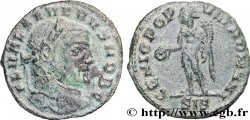
 Details
Details